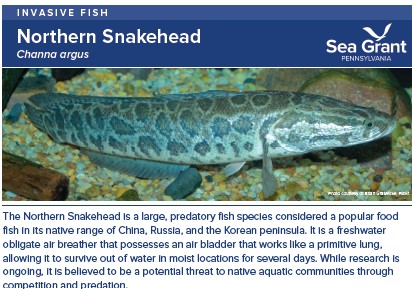
Northern Snakehead (Channa Argus)
Species at a Glance
The Northern Snakehead is a large, predatory fish species considered a popular food fish in its native range of China, Russia, and the Korean peninsula. It is a freshwater obligate air breather that possesses an air bladder that works like a primitive lung, allowing it to survive out of water in moist locations for several days. While research is ongoing, it is believed to be a potential threat to native aquatic communities through competition and predation.
Species Description
The Northern Snakehead has a long, torpedo-shaped body that can grow to a maximum size of 85 cm (33 in). The dorsal and anal fins are long and continuous, running along the top and bottom of the body and nearly reaching the caudal fin. As the name implies, the scaled head of the fish looks similar to a snake. The mouth is large with sharp teeth, and it has a truncated tail. Coloration is generally tan to black with irregular blotches or spots along the sides.
The Northern Snakehead is often mistaken for the native Burbot and native Bowfin. The Burbot can be distinguished by its split dorsal fin, a single barbel on the lower jaw, pelvic fins in front of the pectoral fins, and a long anal fin. The Bowfin is distinguished by a rounded tail, scaleless head, no bony plates between the lower jaw bones, pelvic fins at mid-body, and an eyespot near the tail in males.
Native and Introduced Ranges
Native to China, Russia, and Korea, the first reported breeding population of the Northern Snakehead in U.S. waters was discovered in a Crofton, Maryland pond in May 2002. Since then, it has been found in FDR Park in Philadelphia and in the nearby Delaware River.
Biology & Spread
The sale of live Northern Snakehead in pet shops and live food-fish markets in the United States may have contributed to its introduction. When it grows too big for aquarium tanks, uninformed pet owners may have released it into the wild. It is thought that many recent introductions are intentional releases by anglers desiring to establish a recreational fishery for Northern Snakehead. In addition, the Northern Snakehead may have also been released as part of religious or cultural practices.
Habitat
While it can be found in streams, rivers, canals, reservoirs, and lakes, the Northern Snakehead prefers stagnant shallow ponds, swamps, and slow streams with mud or vegetated substrate. It can tolerate low oxygen conditions and a range of temperatures, from 32-86°F (0-30°C), including ice-covered waters. The Northern Snakehead has an air bladder which allows it to survive out of water, in moist conditions, for several days.
Impacts
Threat to Biodiversity
While diet studies show that the Northern Snakehead has the potential to compete directly with native species for food and habitat, its impacts remain largely unknown. It is an opportunistic feeder and may prey directly on native fish, crustaceans, frogs, and small reptiles. There is concern that the Northern Snakehead could be a potential vector for protozoal, monogenean, and trematode parasites, the presence of Largemouth Bass virus (LMBV), and mycobacterial infections.
Prevention & Control
- It is unlawful in Pennsylvania to possess, sell, or purchase any Snakehead species. It is also unlawful to introduce, import, or stock any Snakehead species into Pennsylvania waters.
- Know how to identify the Northern Snakehead and distinguish it from native Bowfin and Burbot.
- Harvest of this species is encouraged, but all captures should be reported to the Pennsylvania Fish and Boat Commission.
- Take photographs and make note of capture location, because the information is useful for determining distribution and possible control methods.
- Never release plants, fish, or animals into a body of water unless they originated from that body of water.
- Always check for and remove any plants, mud, and debris from boats, trailers, clothing, and equipment before leaving a water body.
- Unused live bait should be disposed of in the trash; it is unlawful in Pennsylvania to release any unused live bait.
References:
Courtenay, W. and Williams, J.D. Snakeheads (Pisces, Channidae) A Biological Synopsis and Risk Assessment. US Geological Survey Circular 1251. <http://fisc.er.usgs.gov/Snakehead_circ_1251/circ_1251_courtenay.pdf >.
Aquatic Invasive Species Control Plan: Northern Snakehead.2023. Pennsylvania Fish and Boat Commission. Website.



